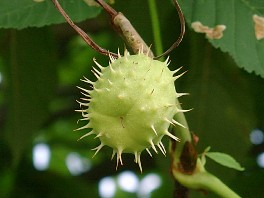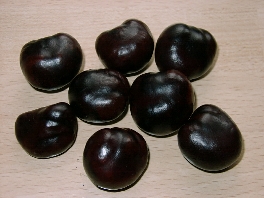 The Horse Chestnut is a big tree that grows in parcs and at roads.
Its size makes the Chestnut play a dominant role.
The Horse Chestnut is a big tree that grows in parcs and at roads.
Its size makes the Chestnut play a dominant role.
Kids know very well where Chestnut-trees grow because they can find the shining brown seeds in autumn to construct figures out of them.
Chestnuts have a lot of medical uses.
To strengthen the veins ist the most wellknown use of them.
Therefore you can use the Chestnut against varicose veins, haemorrhoids and Phlebitis.
Medicinal Uses
- Astringent
- Antibacterial
- Blood cleaning
- Stops bleeding
- Inflammation-inhibitory
- Diuretic
- Spasm-dissolvent
- Mucus-dissolvent
- Analgesic
- strengthening
- Fever
- Cold
- Whooping coughs
- Edemas
- Circulation strengthening
- Arteriosclerosis
- Diabetes
- Diarrhea
- Stomach convulsions
- Liver weakness
- Rheumatism
- Gout
- Sciatica
- Nerve pain
- Frostbites
- Skin problems
- Eczemas
- Ulcers
- Lupus erythematodes
- Wounds
- Phlebitis
- Haemorrhoids
- Varicose veins
- Discharge
- Vein diseases
- Leg sore
Information
| Used Parts: | Fruits, Bark, Flowers, Leaves, Root |
| Substances: | Aesculine, aescine, Allantoin, Angelic acid, Bitter essence, Tannin, Camphorated oil, Choline, Cyanidine, Flavone, Flavo-glykoside, Fraxin, Tannic essence, Tannic acid, Geraniol, Coumarin, Linolenic acid, Saponins |
| Time to collect: | Bark: March, Flowers: May, Seeds: September and October |
Methods
 Nearly all parts of the Chestnut tree can be used as a remedy.
Nearly all parts of the Chestnut tree can be used as a remedy.
The main use is to cure the veins and arteries. The Chestnut can help against varicose veins and haemorrhoids.
Because of the high content of saponins you shouldn't overdose the internal use of the Chestnut.
Fruits / Seeds
You can use the seeds as a tea or a tincture to strengthen the veins. It doesn't only help against varicose veins but also against swollen feet, because the liquid of the tissue is brought back to the veins and up to the heart.The Chestnut seeds are very good against arteriosclerosis also.
Often creams and ointments are prepared from the seeds of the Chestnut. They can be used to cream the legs for a better blood supply.
Beside the use for the blood vessels Chestnut seeds can be used against cough, rheumatic or neuralgic pains and problems of the digestive system.
Flowers
The flowers of the Chestnut have similar medical uses than the seeds.They strengthen the blood vessels as their main use.
A tea of the flowers is good against cough also.
When you prepare a tincture of the flowers you can use it against rheumatic pain.
The flowers of the white and the red Chestnut and the buds are used as Bach Flowers.

Leaves
The leaves can be used as a tea against fever and cough.They are also a tonic and the help the circulation system.
Bark
The bark of the Chestnut inhibits inflammation, and also works adstringend an diuretic.You can use it against fever, pains and to narrow the veins.
Therefore you can use it against varicose veins like the other parts of the Chestnut. And you can take it also when having a flu.
Externally you can use it as a cream or washing against vein problems
and against lots of problems with the skin like eczemas or ulcers.
Some say it can help against Lupus erythematodes, but this ist not sure.
Plant description
 The Chestnut tree origins from India, Central Asia and Southeast Europe.
The Chestnut tree origins from India, Central Asia and Southeast Europe.
As it is very beautiful and can withstand dirty air it is grown in cities very often, either in parcs or beside streets.
The tree becomes up to 30 meters high.
It has huge leaves that have seven fingerlike leaves.
In May the Chestnut tree flowers with big white or red panicle blossoms, that stand on the branches like thick candles.
In autumn the seeds ripen. They sit in a green spiky capsule. The seeds are brown and glossy, sometimes called conker.
